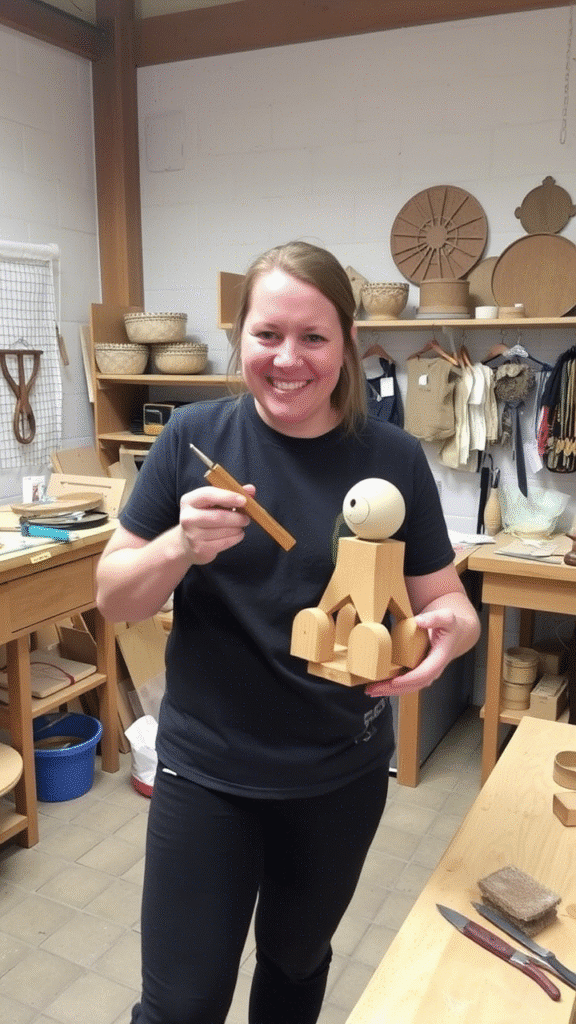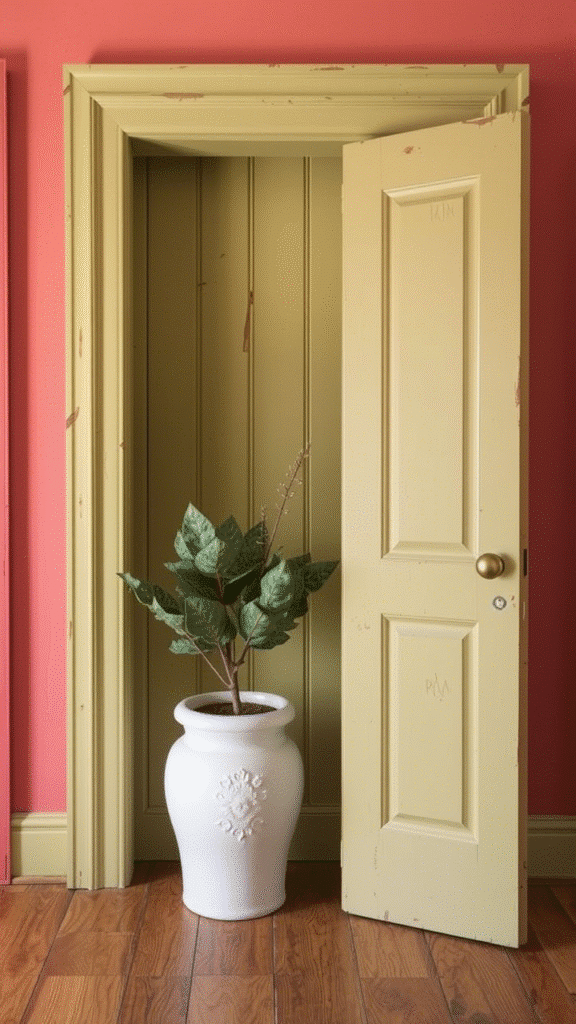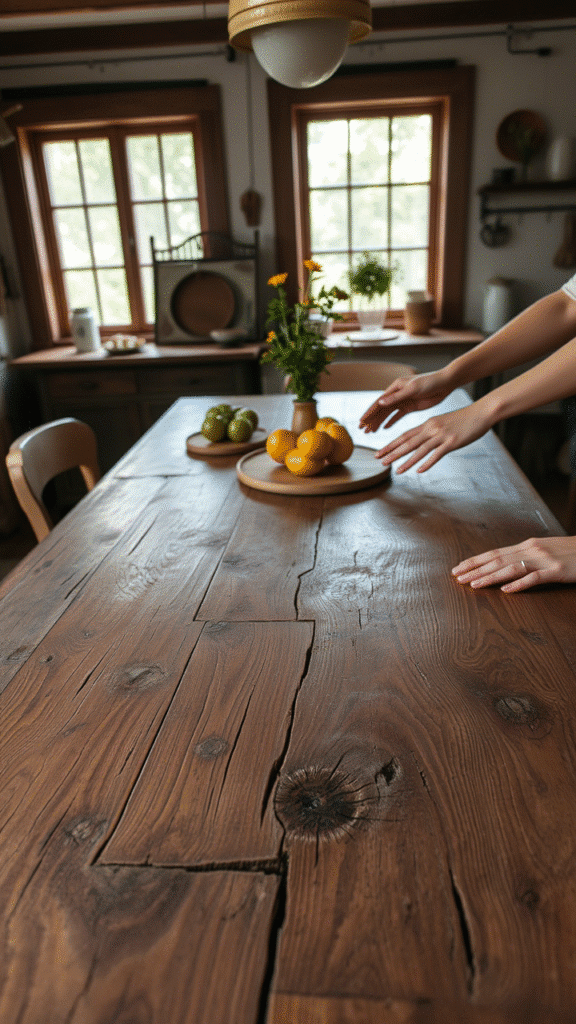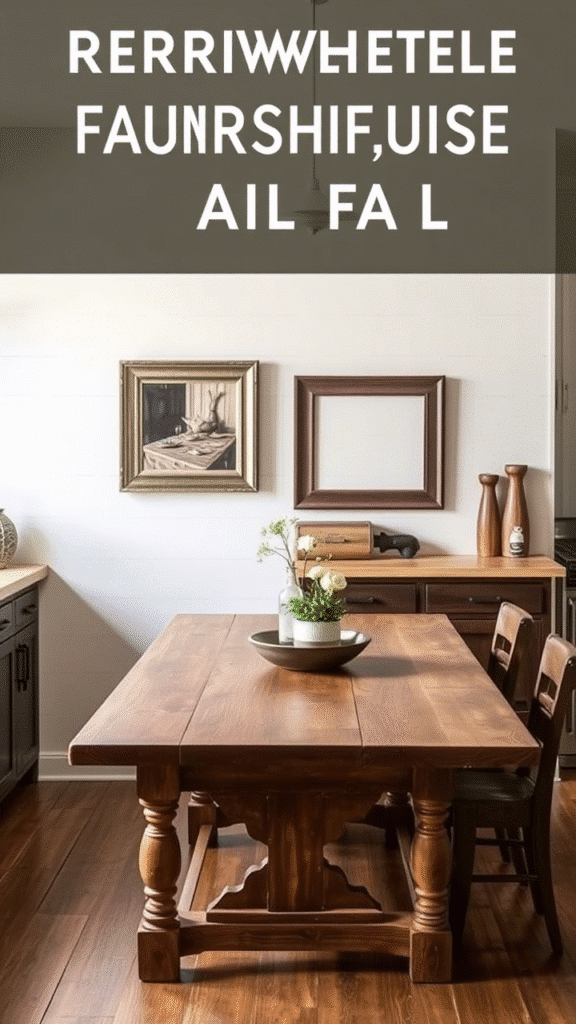Old farmhouse tables—they’ve lived lives, heard stories, seen meals and messes and morning coffee spills. Most folks toss ’em when they get wobbly or scratched up. But lemme tell you, there’s something magical in giving those tired ol’ planks a brand new voice.
So what do you do with a beat-up farmhouse table? You make a dang centerpiece. Not just some dusty thrift shop candle holder. Nah. We’re talkin’ a bold, rustic, slightly rebellious kinda beauty—one that steals attention like a stray dog crashin’ a barbecue.
Why Use an Old Table for a Centerpiece?
First off—wood like that don’t grow on trees anymore. Literally. That thick, grainy, solid oak or pine? Try finding it at the local hardware shop without selling a kidney. These old tables got soul.
Repurposing a table means you ain’t just saving wood. You’re savin’ history. That knot near the edge? That’s where someone dropped a hot pot fifty years ago. That deep groove? Maybe a kid was carving their initials while momma yelled from the porch.
Every scratch tells a tale, and that makes your centerpiece more than decor. It makes it a story.
Step One: Salvage with Purpose
You can’t just grab a table, chainsaw it, and hope it turns out okay. Well, you can, but odds are you’ll end up with a pile of regret.
Pick your table with care. Make sure the wood ain’t rotten or moldy. Weathered is fine—weathered is good. You want character, not termites.
Sometimes you’ll find ’em on the curb. Sometimes at estate sales. I once saw one sittin’ in a ditch, half sunk in mud. Took it home anyway. It turned out better than my last relationship.
What Can You Actually Make?

Here’s where it gets real fun.
You could go traditional and do a long, low wooden box. Stuff it with greenery. Drape a string of fairy lights in there. Boom—instant drama.
Or maybe slice that tabletop into planks. Sand ‘em, stain ‘em, line ’em up in a criss-cross, barn-door style base. Stack candles or mini pumpkins, depending on the season. You’ll be shocked what even 2 feet of old pine can become.
Wanna go rogue? Chop the legs off and make ‘em candle holders. No joke. Table legs got that curvy farmhouse flair, and they make wild, eye-catching stands once you drill a hole up top.
Tools? Nothing Fancy.
Don’t overthink it. You don’t need a whole dang woodworking shop.
A saw. Some wood glue. Maybe a couple clamps and sandpaper. That’s pretty much the holy trinity.
Oh, and patience. Can’t buy that, though. You either got it or you don’t. And trust me, sanding old wood takes some zen.
If you’re the kind who cuts corners, don’t even start. That edge ain’t gonna bevel itself.
Sanding Like You Mean It
Now lemme tell you about sanding.
It’s boring. It’s dusty. It’s weirdly spiritual.
Start with coarse grit—maybe 60 or 80 if the wood’s rougher than a cat’s tongue. Work up to 120 or 220 if you want that smooth, buttery touch.
Wipe it clean every now and then. Feel it with your bare hands. Run your palm over the grain like you’re checking for secrets.
Trust me, you’ll know when it’s right. It hums back at ya, like a song in your fingertips.
Color or No Color?

Here’s the thing—paint is fine. But sometimes you just wanna let that old wood speak.
A light stain can pull out grain you didn’t even know was there. Dark walnut gives drama. Golden oak feels warm and homely. Or just slap on some clear wax and let the raw age show off like a well-earned tattoo.
But hey, wanna go bold? Paint it turquoise. Stencil in your last name. Glue on old keys or rusted knobs from the same table’s drawers. There ain’t no rules—just vibes.
The Secret Weapon: Contrast
Wanna make that centerpiece pop? Use contrast.
Old, rough wood paired with shiny glass jars. Metal candlesticks stuck into rustic slabs. Lace doilies laid over jagged reclaimed edges.
It’s the mix of soft and hard, shiny and matte, worn and new. That’s what gets people staring at your table, asking, “Where’d you get that?”
And you can just smirk and say, “Made it from my grandpa’s old table.” Instant legend status.
Think Beyond Seasons
Sure, folks love to make fall centerpieces or Christmas stuff. But think year-round.
Use succulents in spring. A bowl of lemons in summer. Pinecones and moss come winter. Or leave it bare and let the wood speak for itself.
Minimal ain’t boring when the piece has soul. A single iron lantern on a block of oak says more than a grocery-store bouquet in a plastic vase ever could.
Unexpected Details

Now here’s where things get spicy.
Carve initials into the side. Add old nails just for the look. Tie bundles of dried lavender with string and hang ’em from a dowel across the middle.
I once glued an old spoon to the center of a plank—because it looked cool. No real reason. People loved it. Said it reminded ‘em of their grandma’s kitchen.
Point is—don’t overthink. Let the piece tell you what it wants.
Where to Place Your Masterpiece
Dining tables, sure. But also coffee tables. Buffets. Kitchen islands. Entry tables.
Heck, I put one on top of my piano. Balanced a record player on it. Looks like rustic meets rock ‘n roll.
These things ain’t just centerpieces—they’re mood-setters. Room shifters. Whole personality changers.
And if you’re clever, you’ll switch out the decor pieces every couple weeks. Keeps things fresh. Keeps folks guessing.
Bonus Ideas for the Brave
Want something really out there?
Slice the table into a circular tray. Add some rope handles. You’ve got a serving board with actual history in it.
Or go vertical. Take part of the tabletop and mount it to a wall like a mini mantel. Place candles, a mirror, or dried flowers up top. It’s not just a centerpiece then—it’s wall art.
Even made a tiered stand once. Used old spindles from table legs between levels. Looked like something from a French bakery. Folks were drooling over cupcakes and craftsmanship both.
Where Imperfection Becomes the Point

The cracks? The stains? The uneven edges? That’s the gold.
Don’t sand it all away. Don’t try to make it perfect. Ain’t nobody perfect, and your centerpiece shouldn’t be either.
A little warp makes it charming. A burn mark gives it edge. Let that piece be honest.
People crave that raw, real, imperfect beauty. Feels more human. More grounded.
Don’t Forget the Finish
Once it’s sanded and painted or stained, seal that sucker.
Polyurethane works, but gets shiny. Beeswax is warm, smooth, more natural. Tung oil goes deep and brings out the drama.
Whatever you use—don’t skip it. Protect that wood. Give it a shield so it can live another hundred years.
It’s earned it.
From Trash to Treasure, Literally
Folks walk right past old tables, thinkin’ they’re junk.
But here you are. Seeing possibility. Grabbing your tools. Tearing it down and building it back up.
Not everyone sees magic in the broken stuff. But if you do? You’re already ahead of the game.
Involve the Past

Got an old photo of the original table in use? Frame it. Place it beside the centerpiece. It’s like honoring your ancestors and showing off your skills.
You could even write the table’s story on a tag and tie it to a jar. People love a good backstory. Makes the piece feel alive.
Gifting a Centerpiece
Best dang gift you can give someone, hands down.
Especially if it came from a shared family table or the same barn they grew up near. Wrap it in kraft paper. Add some jute string. Maybe a sprig of rosemary or dried orange slice.
Looks rustic, smells lovely, and hits right in the nostalgia.
Don’t Wait for Perfection
Here’s the truth—your first try might be janky.
Crooked cuts. Patchy stain. A nail in the wrong spot.
That’s fine.
You’ll learn. You’ll get better. And that first one will always hold a special place. Like your first dog, or first terrible haircut.
The only mistake is not starting.
Why It Matters

It ain’t just about saving wood or being crafty.
It’s about slowing down. Using your hands. Giving something old a new story.
In a world full of fast, fake, and throwaway—making a centerpiece from a repurposed farmhouse table is downright rebellious.
It’s grounding. It’s real. It’s yours.
Final Thought
Don’t let those old tables go silent. Take ’em apart, sand ’em down, and turn ’em into somethin’ that makes people stop mid-sentence. Build with love. Sand with patience. Finish with pride.
Ain’t just a centerpiece—it’s a statement. And trust me, the table would thank ya.
FAQs
1. Can I use a table with water damage?
Yep—but make sure it’s not soft or moldy. A little discoloration adds charm. A lotta rot? Not so much.
2. What’s the best type of wood for these projects?
Old oak, pine, or walnut work great. They age beautifully and hold up real nice.
3. Can I make centerpieces without power tools?
Sure can. A hand saw, hammer, and elbow grease go a long way. Just expect some muscle aches.
4. How do I keep the centerpiece looking good over time?
Dust it regular. Reapply wax or oil every few months. Avoid letting water sit on it too long.
5. Is it okay to mix wood types in one piece?
Absolutely. In fact, it adds visual interest. Just make sure they’re similar in thickness and you’re golden.
